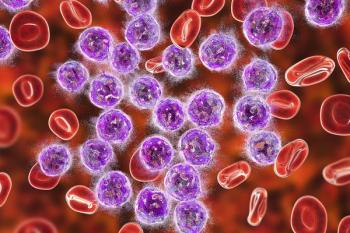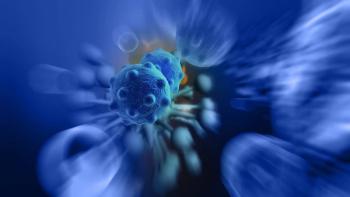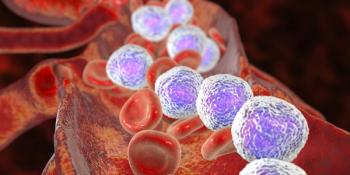
Oncology NEWS International
- Oncology NEWS International Vol 15 No 3
- Volume 15
- Issue 3
Bcr-Abl Transcript Reduction in CML Continues With Ongoing Imatinib Therapy, IRIS Update Demonstrates
An updated analysis of IRIS (International Randomized trial of Interferon/Ara-C versus ST1571), a trial of imatinib (Gleevec) vs interferon, shows that patients with chronic myelogenous leukemia (CML) who respond well to treatment after 12 months may go on to even further eradication of disease after 4 years.
ATLANTAAn updated analysis of IRIS (International Randomized trial of Interferon/Ara-C versus ST1571), a trial of imatinib (Gleevec) vs interferon, shows that patients with chronic myelogenous leukemia (CML) who respond well to treatment after 12 months may go on to even further eradication of disease after 4 years.
"It's important to understand this concept that the higher the number of the log reduction [from a standardized baseline value for untreated patients], the fewer the Bcr-Abl transcripts in peripheral blood," John M. Goldman, MD, said at the 47th Annual Meeting of the American Society of Hematology (abstract 163). Dr. Goldman, professor of hematology, Imperial College, London, is currently a Fogarty Scholar in Residence, Hematology Branch, National Heart, Lung, and Blood Institute (NHLBI).
He explained that with a 2 log reduction in leukemia cells (Bcr-Abl transcripts), detected through real-time quantitative PCR analysis, patients become negative for the Philadelphia chromosome. At a 3 log reduction, they have a major molecular response, he said, and at about a 4.5 log reduction, no transcripts are detected. The current study evaluated at 4 years the level of Bcr-Abl transcripts in CML patients who had achieved a complete cytogenetic response at 1 year with first-line imatinib therapy. Of 553 IRIS patients enrolled to imatinib, 124 met this criterion and were still receiving imatinib at 4 years, Dr. Goldman told ONI.
Study Results
The 4-year analysis showed further reductions in Bcr-Abl transcripts. While 53% of patients had achieved at least a 3 log reduction at 1 year, at 4 years the rate was 80%. Among the 97 patients with a less than 4 log reduction at 1 year, 35 had a 4 or greater log reduction at 4 years. Mean log reduction in Bcr-Abl increased from 3.08 at 1 year to 3.78 at 4 years (P < .0001).
"Patients classified as high-risk by either Sokal (or Hasford) criteria have a somewhat lower degree of log reduction at 4 years than non-high-risk patients," Dr. Goldman observed. Analysis by Sokal risk group showed that 3 log reductions or more were achieved by 82%, 76%, and 64% of patients in the low, intermediate, and high Sokal risk groups, respectively, at 4 years.
Dr. Goldman concluded, "The level of molecular response at 12 months was confirmed to be predictive for long-term clinical outcomes. . . . There is an optimistic possibility that the risk of disease progression might diminish with the passage of time."
Articles in this issue
almost 20 years ago
FDA Approves Eraxis to Treat Candidemiaalmost 20 years ago
NeoGuide's New Colonoscopy System Addresses ‘Looping'almost 20 years ago
New Budget Plan Cuts NCI Funding by 0.8% for FY 2007almost 20 years ago
Lilly Oncology on Canvas Invites Entriesalmost 20 years ago
Shorter FEC + Pac Ups DFS in Breast Caalmost 20 years ago
Xyotax Fast Tracked for Advanced NSCLC in Womenalmost 20 years ago
FDA Guidances for Early Human Testing of New Drugsalmost 20 years ago
Zactima Gets Fast Track Status for Medullary Thyroid Canceralmost 20 years ago
Darbepoetin During RT Boosts Hb Level, With QOL Benefitalmost 20 years ago
Breast, Colorectal Cancer Care Quality 'Excellent'Newsletter
Stay up to date on recent advances in the multidisciplinary approach to cancer.
































































































